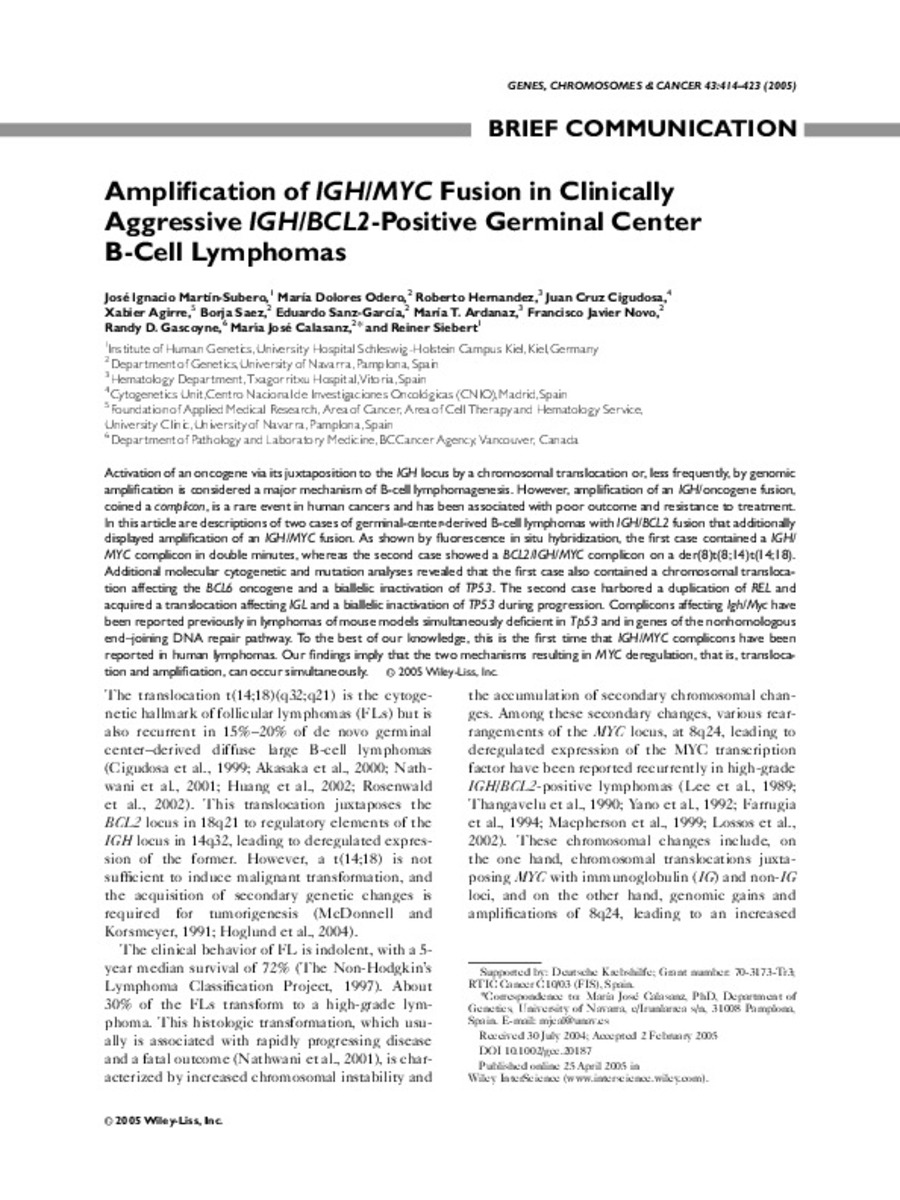Full metadata record
| DC Field | Value | Language |
|---|---|---|
| dc.creator | Martin-Subero, J.I. (Jose Ignacio) | - |
| dc.creator | Odero, M.D. (Maria Dolores) | - |
| dc.creator | Hernandez, R. (Roberto) | - |
| dc.creator | Cigudosa, J.C. (Juan Cruz) | - |
| dc.creator | Aguirre-Ena, X. (Xabier) | - |
| dc.creator | Saez, B. (Borja) | - |
| dc.creator | Sanz-Garcia, E. (Eduardo) | - |
| dc.creator | Ardanaz, M.T. (M.T.) | - |
| dc.creator | Novo-Villaverde, F. J. (Francisco Javier) | - |
| dc.creator | Gascoyne, R.D (R. D.) | - |
| dc.creator | Calasanz-Abinzano, M.J. (Maria Jose) | - |
| dc.creator | Siebert, R. (Reiner) | - |
| dc.date.accessioned | 2011-11-09T13:42:58Z | - |
| dc.date.available | 2011-11-09T13:42:58Z | - |
| dc.date.issued | 2005 | - |
| dc.identifier.citation | Martin-Subero JI, Odero MD, Hernandez R, Cigudosa JC, Agirre X, Saez B, et al. Amplification of IGH/MYC fusion in clinically aggressive IGH/BCL2-positive germinal center B-cell lymphomas. Genes Chromosomes Cancer 2005 Aug;43(4):414-423. | es_ES |
| dc.identifier.issn | 1098-2264 | - |
| dc.identifier.uri | https://hdl.handle.net/10171/19527 | - |
| dc.description.abstract | Activation of an oncogene via its juxtaposition to the IGH locus by a chromosomal translocation or, less frequently, by genomic amplification is considered a major mechanism of B-cell lymphomagenesis. However, amplification of an IGH/oncogene fusion, coined a complicon, is a rare event in human cancers and has been associated with poor outcome and resistance to treatment. In this article are descriptions of two cases of germinal-center-derived B-cell lymphomas with IGH/BCL2 fusion that additionally displayed amplification of an IGH/MYC fusion. As shown by fluorescence in situ hybridization, the first case contained a IGH/MYC complicon in double minutes, whereas the second case showed a BCL2/IGH/MYC complicon on a der(8)t(8;14)t(14;18). Additional molecular cytogenetic and mutation analyses revealed that the first case also contained a chromosomal translocation affecting the BCL6 oncogene and a biallelic inactivation of TP53. The second case harbored a duplication of REL and acquired a translocation affecting IGL and a biallelic inactivation of TP53 during progression. Complicons affecting Igh/Myc have been reported previously in lymphomas of mouse models simultaneously deficient in Tp53 and in genes of the nonhomologous end-joining DNA repair pathway. To the best of our knowledge, this is the first time that IGH/MYC complicons have been reported in human lymphomas. Our findings imply that the two mechanisms resulting in MYC deregulation, that is, translocation and amplification, can occur simultaneously. | es_ES |
| dc.language.iso | eng | es_ES |
| dc.publisher | Wiley-Blackwell | es_ES |
| dc.rights | info:eu-repo/semantics/openAccess | es_ES |
| dc.subject | Gene Amplification | es_ES |
| dc.subject | Genes, bcl-2 | es_ES |
| dc.subject | Genes, myc | es_ES |
| dc.subject | Germinal Center | es_ES |
| dc.subject | Oncogene Proteins, Fusion/genetics | es_ES |
| dc.title | Amplification of IGH/MYC fusion in clinically aggressive IGH/BCL2-positive germinal center B-cell lymphomas | es_ES |
| dc.type | info:eu-repo/semantics/article | es_ES |
| dc.relation.publisherversion | http://onlinelibrary.wiley.com/doi/10.1002/gcc.20187/abstract | es_ES |
Files in This Item:
Statistics and impact
Items in Dadun are protected by copyright, with all rights reserved, unless otherwise indicated.






